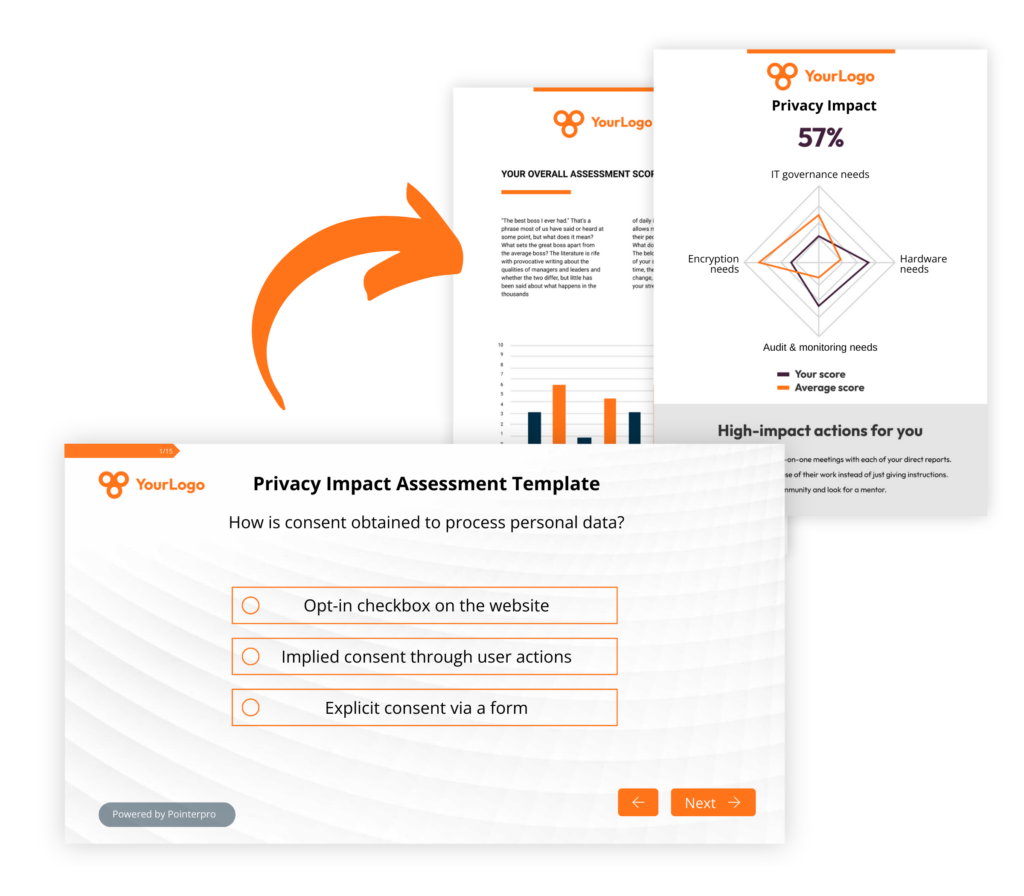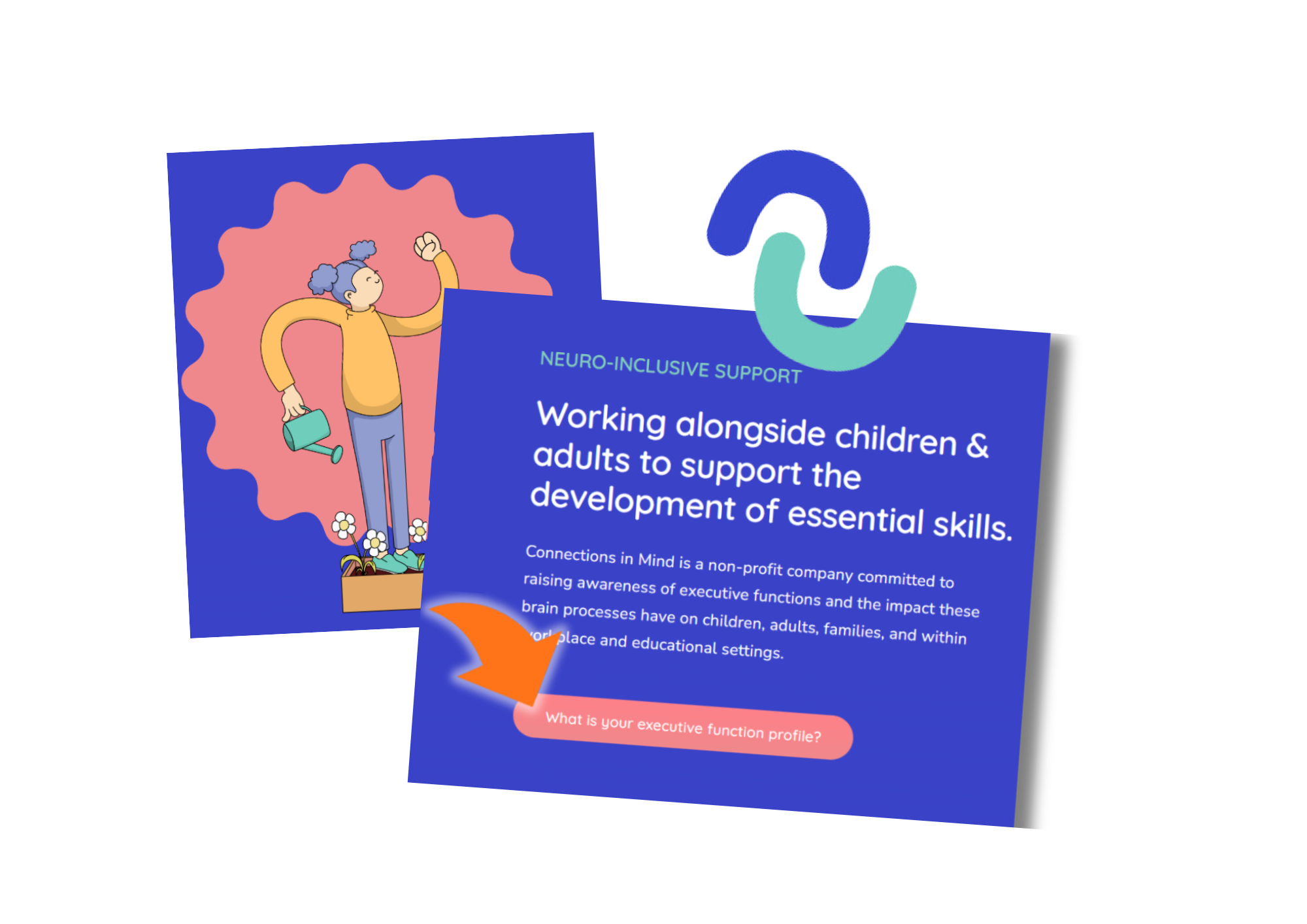Privacy impact assessment template
What if you could build privacy impact assessments that auto-generate tailored and actionable feedback?
PIAs are for upholding data security and privacy. They allow you to identify and address potential privacy concerns before they become problematic.
Pointerpro is the 2-in-1 software that combines assessment building with personalized PDF report generation.

Required actions to carry out a privacy impact assessment (PIA)
A privacy impact assessment (PIA) is a systematic process used to evaluate and manage the privacy risks associated with the collection, use, disclosure, and handling of personal information within an organization. The primary goal of a PIA is to ensure that privacy considerations are integrated into the design and implementation of systems, processes, or projects.
Conducting a privacy impact assessment involves a series of steps to systematically evaluate the privacy implications of a project, system, or process. The exact steps may vary depending on the specific requirements of the organization or relevant privacy regulations, but here is a general framework for carrying out a PIA.
- Initiate the PIA: Initiate the privacy impact assessment by clearly defining the purpose and scope of the assessment. Introduce the project context and identify key stakeholders who play a role in the data collection and processing activities. Establish a clear understanding of the goals and boundaries of the assessment.
- Data overview: Develop a comprehensive overview of the data by listing the types of personal information that will be collected or processed and specifying the sources of this data. Describe the flow of information through the system, outlining how data moves from its origin to its final destination within the project or process.
- Compliance check: Conduct a thorough compliance check by identifying and listing the relevant privacy laws, regulations, and standards that apply to the project. Confirm adherence to key data protection principles by asking specific questions related to consent, purpose specification, and other legal requirements. Ensure that the project aligns with the established regulatory framework.
- Use your privacy impact assessment template: Utilize a structured questionnaire to perform a comprehensive assessment. Identify and evaluate potential privacy risks associated with your project. Formulate questions that assess the impact of these risks on individuals and the organization. This step is crucial for understanding and addressing potential privacy vulnerabilities.
- Privacy safeguards: Explore the implementation of privacy safeguards by posing questions that elicit information about the measures and controls in place to mitigate identified privacy risks. Focus on security practices, encryption methods, access controls, and other safeguards designed to protect the confidentiality, integrity, and availability of the collected personal information.
- Documentation and review: Emphasize the importance of documentation by asking about the maintenance of detailed records throughout the PIA process. Look into the possibilities of compiling a comprehensive PIA report that summarizes the assessment findings for different stakeholders. Additionally, assess the frequency of reviews and updates to ensure that the PIA remains relevant and aligned with evolving project dynamics and privacy considerations.
3 reasons to use Pointerpro as a privacy impact assessment tool
3 reasons to use Pointerpro as a privacy impact assessment tool
Interactive user experience
With the Questionnaire Builder, you create an engaging PIA. How? With numerous design and layout options, useful widgets, and countless question types.
Refined, score-based analysis
Our custom scoring engine helps you quantify and categorize diverse answers. The result? An objective and nuanced privacy impact assessment based on the respondents’ answers.
Automated feedback in PDF
Thanks to your setup in the Report Builder, respondents instantly get a detailed PDF report: with helpful charts, an objective analysis, and actionable tips.
1.500+ businesses worldwide build assessments with Pointerpro









What is the purpose of a privacy impact assessment template?
The key purpose of a privacy impact assessment (PIA) is to systematically evaluate and manage the potential privacy risks associated with the collection, use, disclosure, and handling of personal information within an organization.
No matter what privacy impact assessment template you use, and no matter what context, these are the primary objectives of a PIA:
- Identify privacy risks: Assess and identify potential risks and concerns related to the processing of personal information. This involves understanding how the data is collected, stored, used, and shared within a specific project, system, or process.
- Ensure compliance: Ensure compliance with privacy laws, regulations, and standards that govern the protection of personal information. PIAs are often conducted to meet legal requirements and demonstrate an organization's commitment to respecting individuals' privacy rights.
- Promote transparency: Foster a culture of transparency by providing a clear understanding of how personal information is being used. This involves informing individuals about the data collection practices and purposes. This promotes openness and trust.
- Integrate privacy by design: Integrate privacy considerations into the design and implementation of systems, processes, or projects from the outset. By identifying and addressing privacy issues early in the development lifecycle, organizations reduce the likelihood of privacy breaches. In the end, it truly enhances overall data protection.
- Mitigate privacy risks: Implement measures and controls to mitigate identified privacy risks. This may involve incorporating privacy safeguards, security measures, and data minimization strategies to protect the confidentiality, integrity, and availability of personal information.
- Protect individuals' rights: Safeguard individuals' privacy rights by ensuring that they have the ability to access their personal information, correct inaccuracies, and exercise other rights granted by data protection regulations.
- Build stakeholder trust: Build trust among stakeholders. That means Customers, employees, and partners. How? By demonstrating a commitment to responsible and ethical handling of personal information. A well-conducted PIA enhances an organization's reputation and fosters positive relationships with those affected by data processing activities.
- Document compliance efforts: Document the organization's efforts to comply with privacy requirements. This documentation serves as a record of due diligence, providing evidence that privacy considerations have been thoroughly examined and addressed.
- Support decision-making: Provide valuable insights that can inform decision-making processes within the organization. The findings of a PIA help stakeholders make informed choices about the design, implementation, and ongoing management of projects, systems, or processes involving personal information.
About GDPR and your privacy impact assessment template (PIA)
A privacy impact assessment (PIA) is closely tied to the General Data Protection Regulation (GDPR) because it helps organizations follow the rules outlined in GDPR when handling people’s personal information.
GDPR sets the Rules: GDPR is a set of rules created to protect the privacy of individuals in the European Union (EU) regarding their personal data. It applies to all organizations active in the EU that collect, process, or store such data.
In the video below, Pointerpro Product Director Bruno takes a shot at explaining GDPR in layman’s terms.
A PIA, more specifically a privacy impact assessment template adapted to GDPR helps you follow the rules: When an organization wants to start a new project or process that involves handling people’s personal information, they use a PIA to assess and manage any potential risks to privacy. It helps them follow the rules and principles of GDPR.
In essence, a privacy impact assessment is a practical tool that organizations in the EU use to make sure they’re doing things the right way according to GDPR. It helps them be responsible custodians of people’s personal data, promoting both legal compliance and trust between the organization and individuals.
In the context of GDPR a privacy impact assessment is always referred to as a DPIA: a Data protection impact assessment. This article of the European Commission delves into when it’s required.
Privacy impact assessment (PIA) vs data protection impact assessment (DPIA)
Though often used interchangeably, because both assessments share the goal of evaluating and managing privacy risks, there is a difference to note.
A PIA is a broader term used for assessments conducted to evaluate privacy implications in various contexts, while a DPIA is a more focused assessment required when processing activities, especially new technologies, are likely to result in high risks to individuals’ rights and freedoms.
A DPIA, as per GDPR, has specific criteria. These include assessing the necessity and proportionality of the processing, evaluating potential risks, and proposing mitigating measures. So in summary, while all DPIAs are PIAs, not all PIAs are DPIAs, as the latter is a more specialized form mandated by GDPR for high-risk data processing activities.
20 privacy impact assessment example questions
Here are 20 privacy impact assessment example questions divided into 2 well-known categories:
- 10 privacy impact assessment example questions for GDPR
- 10 privacy impact assessment example questions for NIST
10 privacy impact assessment example questions for GDPR
Here are 10 privacy impact assessment template questions that could be included in a Privacy Impact Assessment (PIA) specifically tailored for compliance with the General Data Protection Regulation (GDPR):
- What personal data will be collected and processed?
- What is the legal basis for processing personal data?
- How is consent obtained for processing personal data?
- Is the collected personal data limited to what is necessary for the intended purpose?
- What measures are in place to ensure the security and confidentiality of personal data?
- Will the personal data be shared with third parties?
- What is the defined retention period for the personal data?
- How are individuals informed about their rights under GDPR?
- Will personal data be transferred outside the European Economic Area (EEA)?
- Was a Data Protection Impact Assessment (DPIA) conducted for high-risk processing activities?
10 privacy impact assessment example questions for NIST
- What are the specific goals and objectives of the system or project?
- How is personal information categorized based on sensitivity and criticality?
- What measures are in place to ensure the confidentiality, integrity, and availability of the personal information?
- Are there established access controls and mechanisms for authentication and authorization?
- How is data shared within the organization and with external entities?
- What is the process for detecting and responding to privacy incidents or breaches?
- How is data quality and accuracy maintained throughout its lifecycle?
- Are there mechanisms for individuals to exercise their privacy preferences and rights?
- How often is the privacy program reviewed and updated in response to changes?
- Has a comprehensive privacy risk assessment been conducted for the system or project?
These privacy impact assessment template questions guide organizations in evaluating the privacy implications of their systems or projects and aligning with the principles outlined in the NIST Privacy Framework. The approach involves a systematic assessment of privacy risks, data protection measures, and ongoing compliance efforts to enhance privacy and cybersecurity practices, with a focus on flexibility and global applicability.
The National Institute of Standards and Technology (NIST) is a U.S. federal agency that develops and promotes standards and guidelines to enhance the cybersecurity and privacy posture of organizations. NIST’s guidelines, particularly those outlined in documents such as the NIST Privacy Framework, provide a structured approach to managing privacy risks.
While GDPR is a European regulation focused on protecting individuals’ privacy rights, NIST offers a more general framework applicable globally. Both GDPR and NIST emphasize the importance of risk assessment, security measures, and ongoing compliance efforts, but they differ in their geographic scope and the level of specificity in their requirements. NIST provides a flexible framework that organizations worldwide can adopt to enhance their privacy practices and cybersecurity measures.
What Pointerpro clients are saying




6 commonly known privacy impact assessment templates
- Open source privacy impact assessment (OSPIA) framework: An open-source framework designed for assessing the privacy impact of software applications. It includes sections on data collection, data storage, data sharing, and data retention
- Privacy by Design Template: Based on the Privacy by Design framework, this privacy impact assessment template emphasizes integrating privacy considerations into the design and operation of systems, services, and business practices.
- DHS privacy impact assessment template: Used by U.S. federal agencies, this template includes sections on data collection, purpose specification, use limitations, and data retention, helping organizations comply with the Privacy Act of 1974.
- EDPS privacy impact assessment template: Tailored to comply with the GDPR, this template assists organizations in conducting Data Protection Impact Assessments, covering areas such as data processing, risk assessment, and mitigating measures.
- IAPP privacy impact assessment template: Developed by a leading privacy professional association, this template covers various aspects of privacy assessments and aligns with global privacy standards.
- Privacy Analytics privacy impact assessment template: Developed by Privacy Analytics, this template emphasizes risk assessment and mitigation strategies, providing a structured approach to assessing the privacy impact of data processing activities.
Create your privacy impact assessment today
You may also be interested in
Recommended reading

How Connections In Mind benefits the community interest through a digital mindset and a longitudinal assessment
The fact that communities benefit from diversity should not be news to anybody. One type of diversity you may not

Vlerick Business School digitalizes entrepreneurship development with Pointerpro [case study]
What do a top-tier international business school based in the capital of Europe and Pointerpro have in common? At the

Attain Global: How to do psychometric tests right and build a cutting-edge international business [case study]
In many countries worldwide, the pursuit of skillful and engaged employees is not so much a war on talent as


